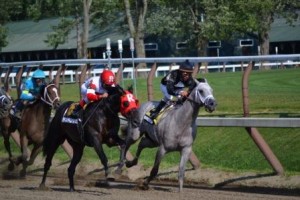Apr 5
2015

When handicapping, I will sometimes make the notation, “Needs The Lead” at the top of a horse’s Past Performances (PPs). Meaning they do their best (and sometimes only) running when they are happily cruising on an uncontested lead at the front of the pack.
Now, if the horse is running in a race on a speed favoring surface, or happens to be the “only” speed in the race, I will color code my comment in Blue (for a good thing). But, more times than not I don’t view this trait as a “good thing.” Especially if there are other “Needs The Lead” horses in the same race or if the horse in question doesn’t seem to have superior speed to establish an easy lead.
Read More >>
Sep 16
2014
In a prior article we discussed the dynamics of a horse “stretching out” from a short race (sprint) to a longer race (route). In particular, we covered the paradox that often occurs when a horse closes in a sprint race, comes up short, and appears to just “need a little more ground.” Click here for review of that article.
In that article we provided an example of a horse named Pan Dulce, who finished 2nd in a 6-furlong race at Belmont, and subsequently was the 9-5 favorite in an 8-furlong race at Saratoga. Unfortunately, for supporters of this horse, she tired in that race and was a well beaten 3rd. But, the story doesn’t end there, and in fact her next move back into a sprint race provides material for the cutback angle. Read More >>
May 12
2014
UPDATE: Article was updated on April 25, 2015 to include information from the 2014 Preakness.
As we get nearer to the 2nd leg of the Triple Crown, it’s time to separate fact from opinion when it comes to the running style most suited to winning The Preakness Stakes at Pimlico racetrack. So, we decided to go back eleven years and chart the running style for the first three finishers and how they ran in The Preakness Stakes that year. Before we show the chart, let’s first define the running styles.
- Early Speed – A horse that breaks quickly from the gate and establishes themselves either on the lead, or very close to it.
- Stalker – A horse that sits behind the early speed horses, and is positioned no further back than mid-pack.
- Closer – A horse that is mid-pack or further back early in the race, and did it’s best running in the later stages of the race.
Read More >>
Apr 13
2014

I went down to Aqueduct on April 5,2014 with a couple of racing buddies to witness the Wood Memorial and a couple of other quality stakes races. Among those were the 9-Furlong Gazelle Stakes for 3-year old fillies and the 7-Furlong Carter Handicap for 3-year olds and up. Both race outcomes were a reminder of a fundamental tenet in horse racing – uncontested leads are hard to overcome – regardless of the distance.
In the Gazelle Stakes, My Miss Sophia was the 4-5 betting favorite. Prior to this race, she had only two career races, both maiden races; one at 5.5 furlongs and the last at 8 furlongs. So, today she’s going an extra furlong and she’s facing much more experienced horses, including three that have run and placed in multiple Graded Stakes races. But she has something that none of her rivals have shown in their prior races … the ability to break sharply and position herself on the lead. This capability can result in what handicappers often refer to as an “uncontested lead.” Below is the video replay of the race, it won’t take more than a second to see which number is My Miss Sophia, as she bursts from the gate and goes right to the lead.
Read More >>
Dec 12
2013

When handicapping, I will sometimes make the notation, “Needs The Lead” at the top of a horse’s Past Performances (PPs). Meaning they do their best (and sometimes only) running when they are happily cruising on an uncontested lead at the front of the pack.
Now, if the horse is running in a race on a speed favoring surface, or happens to be the “only” speed in the race, I will color code my comment in Blue (for a good thing). But, more times than not I don’t view this trait as a “good thing.” Especially if there are other “Needs The Lead” horses in the same race or if the horse in question doesn’t seem to have superior speed to establish an easy lead.
Read More >>
Aug 2
2013
In a prior article on Time, we explained how Turf races are frequently run slower at the beginning and faster at the end. In particular, Turf Route (over 1 mile) races almost always fit this description. Why?
Turf racing rewards the horse (and jockey) who can save ground on the turns, cut the corner into the stretch run, and finish strong with a solid closing kick. This is in large part due to the following factors:
- The tighter turns on turf courses.
- The nature of the footing on the turf.
- A horse’s ability to grab hold of the surface while making that closing kick. Read More >>
Jul 31
2013
We’ve covered a lot of ground about distance, class, form, pace, figures, etc. But one area we haven’t touched upon yet is TIME. I frequently get asked questions like, “What’s a good time for a 6-furlong race?”
Of course this varies by track, surface, and weather conditions but a “good time” for six furlongs is around 1:10 (one minute and 10 seconds). This works out to an average furlong time of around 11.6 seconds. Or roughly 12 seconds per furlong. And this is a pretty good start for an average. But, as we will explain, there are lots of ways to get to an average. Read More >>
Jul 29
2013
In a prior article we introduced the concept of Pace Figures and demonstrated an example with the Preakness winner Oxbow on how important they are in evaluating a race. Click here for a review of that article. On Saturday, July 27 I sent a text to my handicapper friend Vince saying “I think Kauai Katie is beatable today.” My thinking was based on the Pace Figures for the race, and my presumption that she is a “need to lead” type of horse. By that I mean a horse that needs to set an uncontested early pace to do their best running. Often, this type of horse gets discouraged if they are pressured early in the race.
First, in case you aren’t familiar with the race outcome, let me set the stage. Kauai Katie opened up at 1-9 odds, and remained that way for a long time. At post time she went off at 2-5 odds. A heavy favorite. Read More >>
Jun 16
2013
If you spend much time at the race track, it’s only a matter of time before you hear a horseplayer say, “Pace Makes the Race.” It’s one of those timeless maxims that has forever been a part of racing and will forever be a part of racing. Entering a race, trainers and jockeys are well aware of the running style for their horse and generally for the other horses involved in the race. For similar reasons, it’s a good idea as a horseplayer to have the same awareness when handicapping a race. Read More >>
May 22
2013
The Running Lines appear smack dab in the middle of the Past Performances (PPs) for each horse in the Daily Racing Form. We have alluded to them already, but in this post we’ll give a full account of what they mean, and how they vary by the distance of the race. All together there are Six columns of positions for the running line of past races. Read More >>


